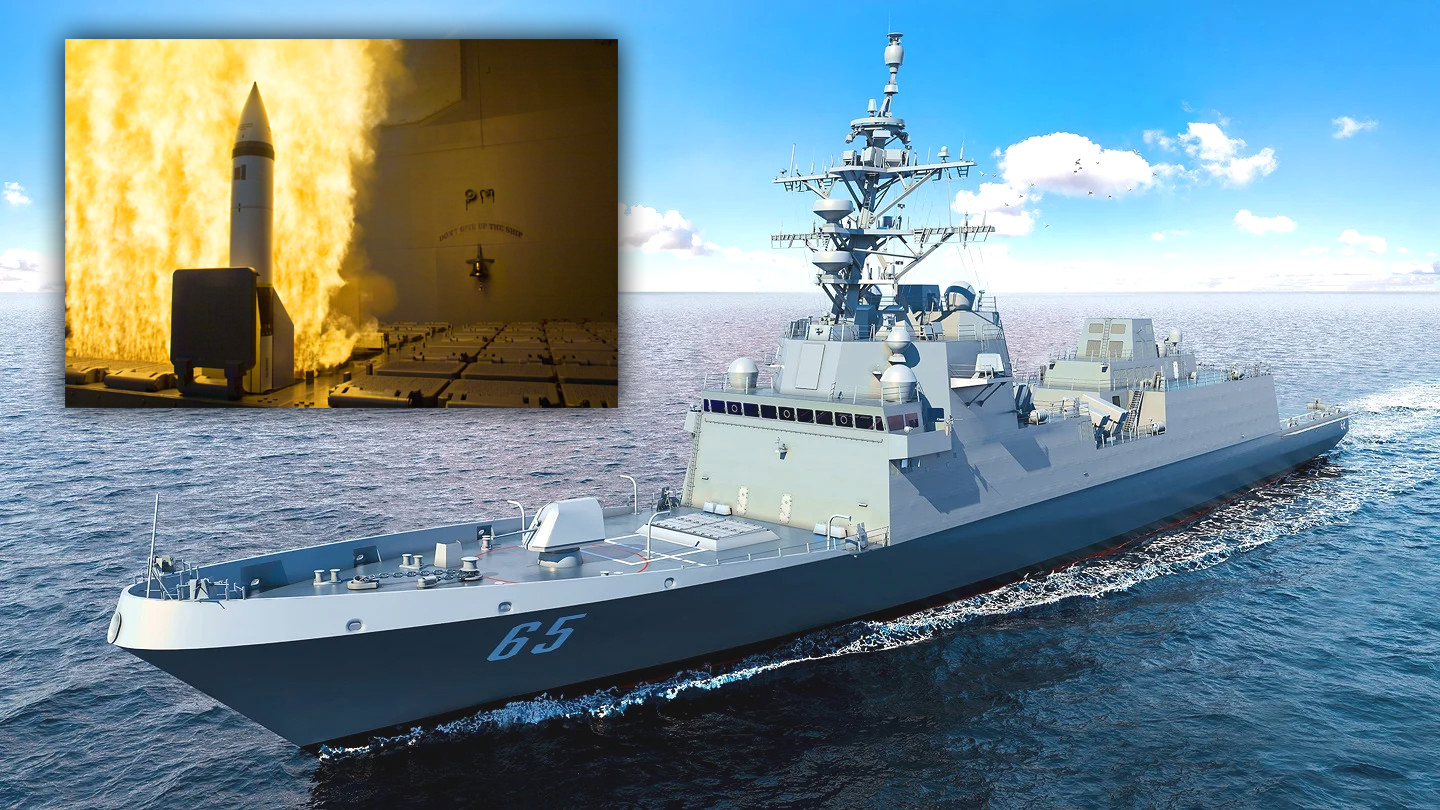As the U.S. Navy continues to wend its way toward acquiring its first batch of Constellation class frigates, a major question remains: is 32 vertical launch system cells enough for these ships?
Debates about the Constellation‘s vertical launch capacity reflects broader concerns, including how these cells might be reloaded at sea in a major conflict, across the Navy as a whole. The underlying issues here have come into sharp relief recently as the service’s vessels have been shooting down dozens of Houthi anti-ship ballistic and cruise missiles and drones and launching strikes on the group in Yemen.
The Connies
The Constellations are set to be the Navy’s next class of small surface combatants and the service has said the past that it wants to buy at least 20 of them in the future. These will be multi-mission ships, with a mixture of anti-air, anti-ship, and anti-submarine capabilities, designed to supplement larger surface action groups or operate independently.
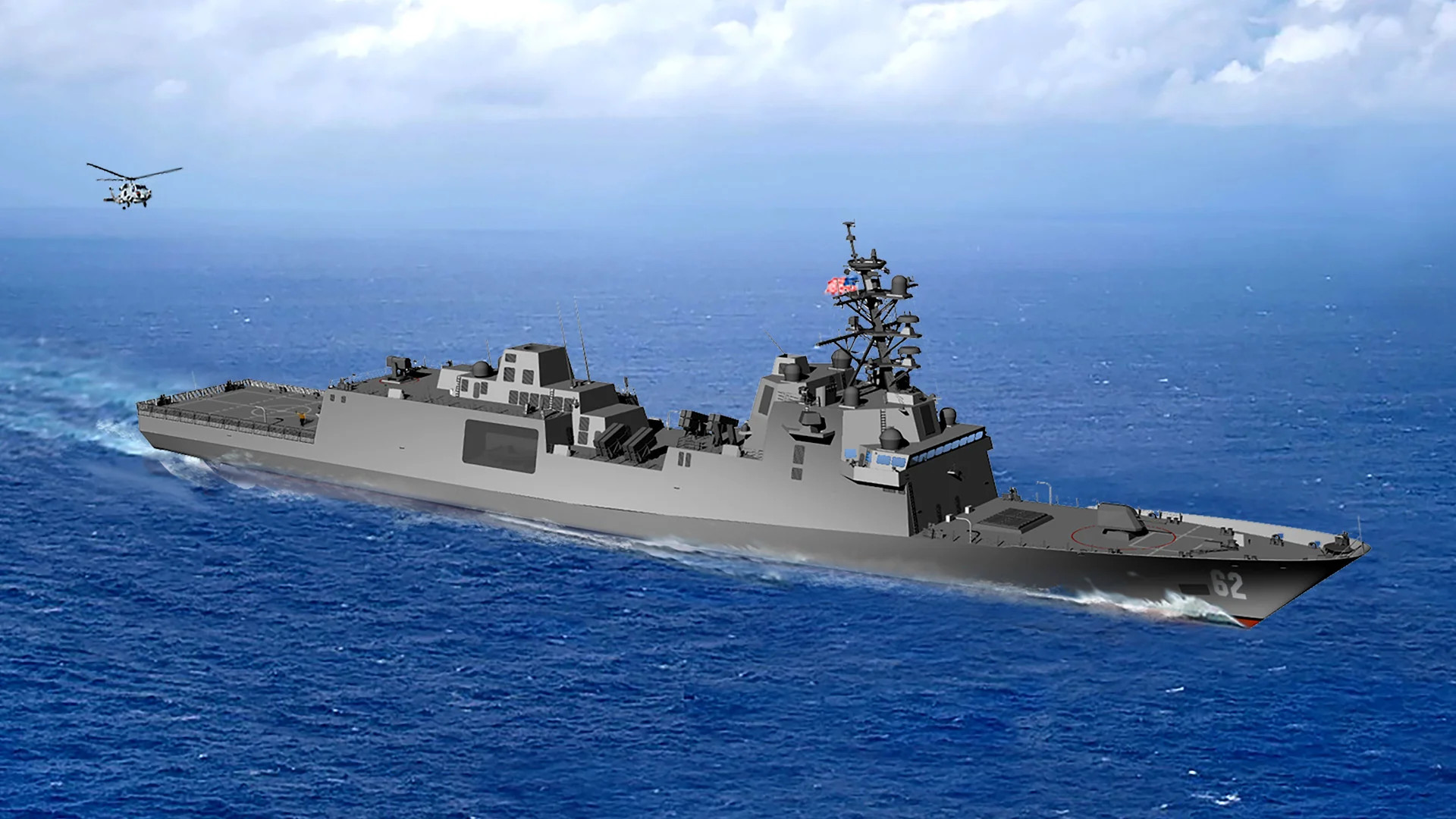
The Navy’s decision to acquire new frigates was a firm rebuke of the two perpetually under-performing classes of Littoral Combat Ships (LCS). The service has acquired some 30 LCSs, in total, since the late 2000s and is still in line to receive more of them, even as it has been sending relatively young ones into mothballs.
Though intended to perform many of the same missions as the Constellation class frigates, both the Freedom and Independence class LCSs have been especially criticized for their very limited armament packages. Their continued lack of air and missile defense capability on the LCSs for anything but close-in defense has been particularly glaring. Freedom and Independence class ships have been prominently absent from the current crisis in and around the Red Sea, which is by definition a littoral combat environment, underlying the ambiguous use case and poor return on investment of these ships many years after they entered into Navy service.

The Navy currently has four Constellations under contract – the future USS Constellation (FFG-62), USS Congress (FFG-63), USS Chesapeake (FFG-64), and USS Lafayette (FFG-65) – all of which will be built by Fincantieri Marinette Marine, a U.S. subsidiary of Italy’s Fincantieri. The Navy currently plans to order four more by the end of the 2028 Fiscal Year and it is still eyeing hiring a second shipyard to accelerate construction of more hulls in the future.
The Navy has also pitched the idea of turning Constellation into a multi-national effort. Just this week, Greece’s Minister of Defense Nikolaos Dendias announced that his country has formally expressed interest in joining the U.S. frigate program and producing up to seven of these ships, or variants thereof, in Greek shipyards.
When the first Constellations will begin to enter service is unclear and dependent on a host of factors. The forthcoming USS Constellation is already at least a year behind schedule, according to a recent report from USNI News. With that delay, the hope is that the first of these frigates will be at least delivered in 2027. The hope is tahat all of the hulls on order now will be in service by 2029.
Constellation And Its Current 32 VLS cells
In 2020, the U.S. Navy announced that it had selected a derivative of the Italian subvariant of the Fregata Europea Multi-Missione (FREMM) design as the winner of its FFG(X) frigate competition. FREMM originated as a Franco-Italian program with a design developed by Italy’s Fincantieri and France’s Naval Group.
It is worth noting that a central FFG(X) requirement was that it be based on an in-production ‘parent’ design, but that the Constellation class ships will be substantially different from existing FREMM types. The ‘Americanized’ FREMM-based Constellation class is longer, wider, and has a greater displacement, among other differences that you can read more about here. These changes and others resulted in the altering of nearly every technical drawing and have been a major factor in production delays to date, according to USNI News.
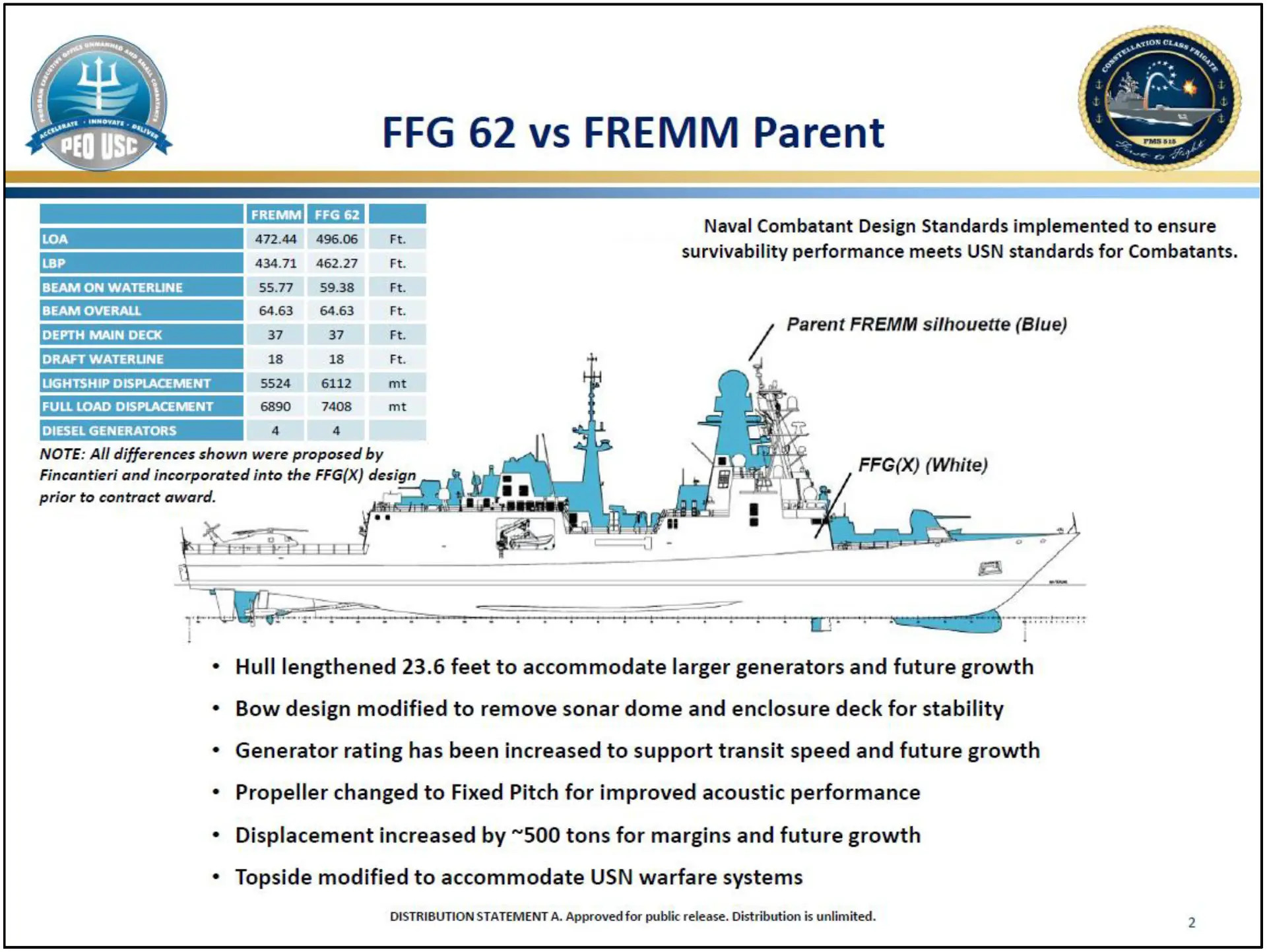
When it comes to vertical launch system (VLS) capacity, there had been questions about the configuration of the Mk 41 array for Navy’s new frigates even before the FREMM-based design was selected. The original threshold requirements for FFG(X), a program that was first announced publicly in 2017, called for just 16 VLS cells. By the time competition was over, this had increased to 32.
For comparison, each of the Navy’s Flight I and II Arleigh Burke class destroyers have 90 Mk 41 VLS cells. Flight IIA and other subsequent subvariants of the Arleigh Burke have 96 cells. The service’s trio of Zumwalt class destroyers feature Mk 57 VLS arrays, derived from the Mk 41, with 80 cells in total (these ships are also getting all new large vertical launch tubes primarily for firing hypersonic missiles). The Navy’s Ticonderoga class cruisers, the last of which are slated to be decommissioned before the end of the decade, have 122 Mk 41 VLS cells apiece. All of these ships are, of course, notably larger than Constellation.
In addition, the Navy’s FFG(X) requirements only called for the ships to carry SM-2 Block IIIC and RIM-162 Evolved Sea Sparrow Missile (ESSM) surface-to-air missiles in their VLS cells. ESSM is small enough that four of them can be quad-packed into a single Mk 41 cell.



During the course of the FFG(X) competition, the Navy also said that it planned to integrate some type of vertically-launched anti-submarine warfare weapon onto these frigates in the future. It’s unclear whether or not this was simply a reference to the Navy’s existing RUM-139 Vertical Launch Anti-Submarine Rocket (VL-ARSOC) family (now also marketed as the Vertical Launch Antisubmarine missile, or VLA) or a follow-on design. All variants of the VL-ASROC/VLA carry a lightweight anti-submarine torpedo as their payload.
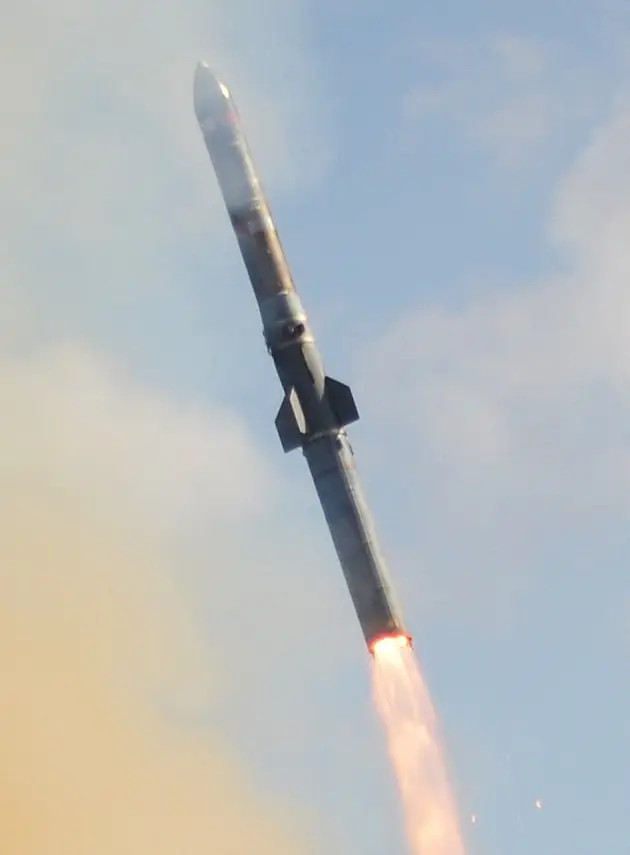
It is unclear what version of the Mk 41 the Navy currently plans to fit on its Constellation class frigates, though it was initially assumed these ships would use a shorter tactical-length version. SM-2 Block IIICs, ESSMs, and VL-ARSOC/VLAs can all be fired from tactical-length variants of this VLS.
However, in the annual defense policy bill, or National Defense Authorization Act (NDAA), for the 2023 Fiscal Year, Congress inserted a requirement that the Navy work toward integrating SM-6 and Tomahawk cruise missiles onto Constellation class frigates starting with the second hull (the future USS Congress). SM-6 and Tomahawk both require longer strike-length Mk 41 VLS arrays.
SM-6 was designed primarily as a long-range surface-to-air missile, but also has the ability to strike targets on land or ships at sea. Tomahawk is similarly focused on the land-attack role, but has anti-ship capability, as well. The Navy is now acquiring a further anti-ship-optimized version of the missile known as the Maritime Strike Tomahawk. In April 2023, USNI News reported that the service said it was seeking to meet the Congressional demand for the integration of these additional missiles onto the Constellation class, but had no firm timeline for doing so.
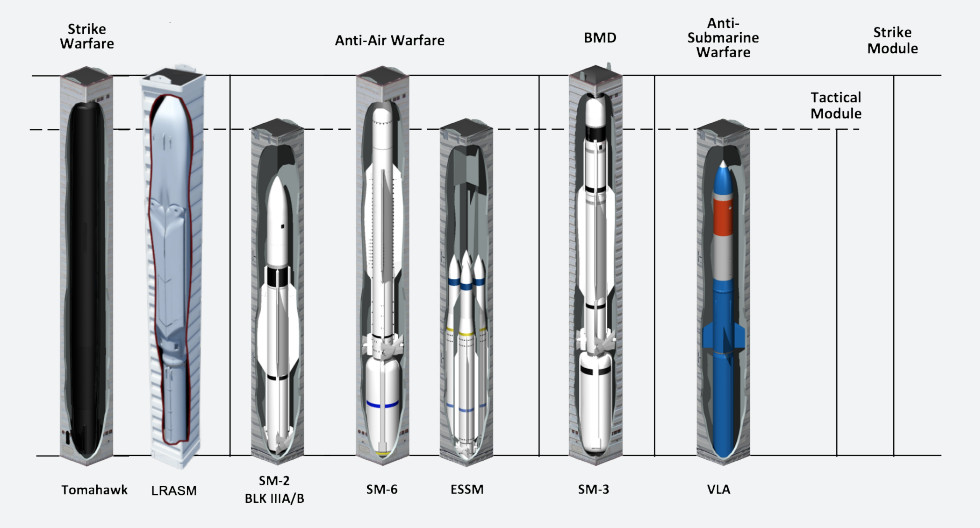
Beyond a strike-length Mk 41 array, some degree of additional modification to the Constellation design would be needed for the integration of the SM-6 and Tomahawk. This would at least include changes to its fire control architecture, including integrating the Tomahawk Weapon Control System (TWCS), and may require more physical alterations that, in turn, would lead to cost increases and increase the risk of schedule delays.
“SM-6 may not be that far out of reach … Tomahawk is a little different. If you were trying to install a Tomahawk suite, like on a Flight III [Arleigh Burke class destroyer], it wouldn’t fit on a frigate,” Rear Adm. Kevin Smith, the Navy’s Program Executive Officer for Unmanned and Small Combatants told USNI News at the Surface Navy Association’s (SNA) 36th National Symposium earlier this month. “It’s been very clear to me from my leadership, we don’t want to make changes to the baseline until we get to a certain point.”
The War Zone has reached out to Naval Sea Systems Command for any new information on the Constellation class’s VLS arrays, what might go into them, and when.
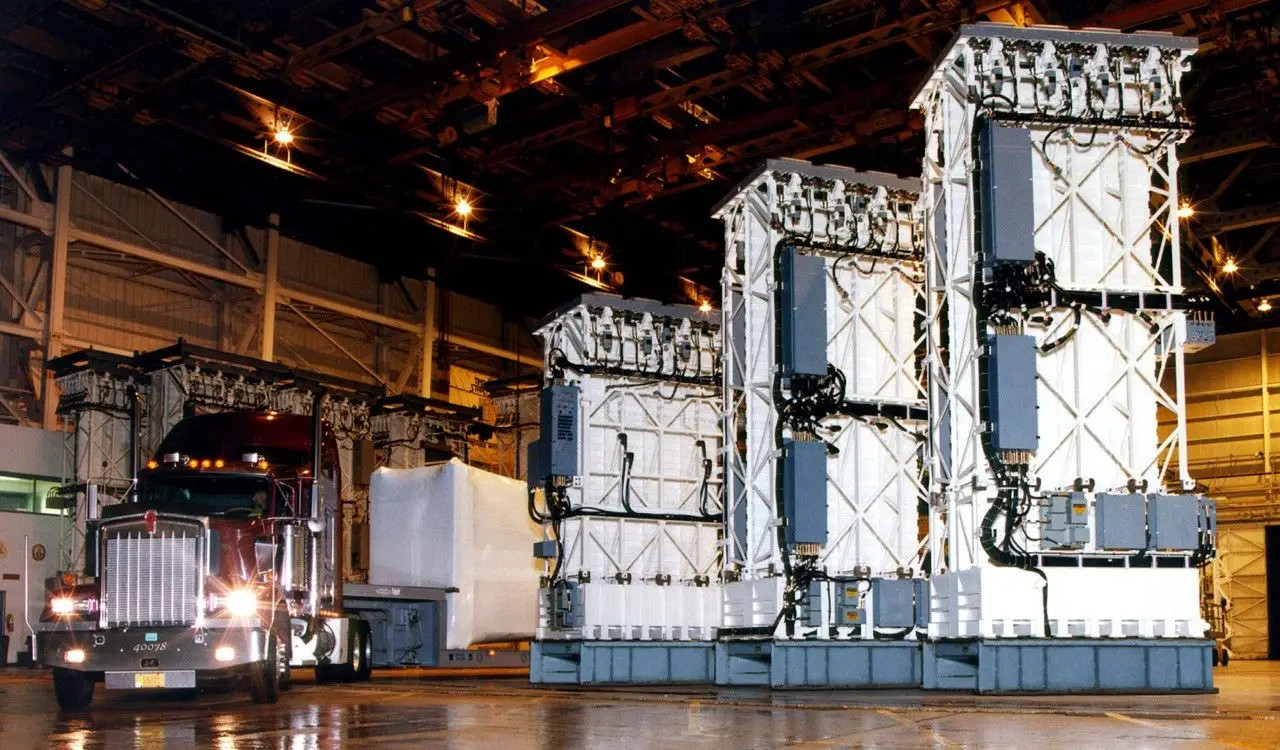
Using a strike-length variant of the Mk 41 would also open the possibility of integration a broader array of missiles down the line. Lockheed Martin, which manufacturers the Mk 41, has demonstrated the ability of a strike-length version to launch an modified AGM-158C Long-Range Anti-Ship Missile (LRASM) with an additional booster.
The company is also now working to pair its Patriot PAC-3 MSE surface-to-air missile with the Mk 41, and is looking to conduct a live-fire demonstration of this combination later this year.
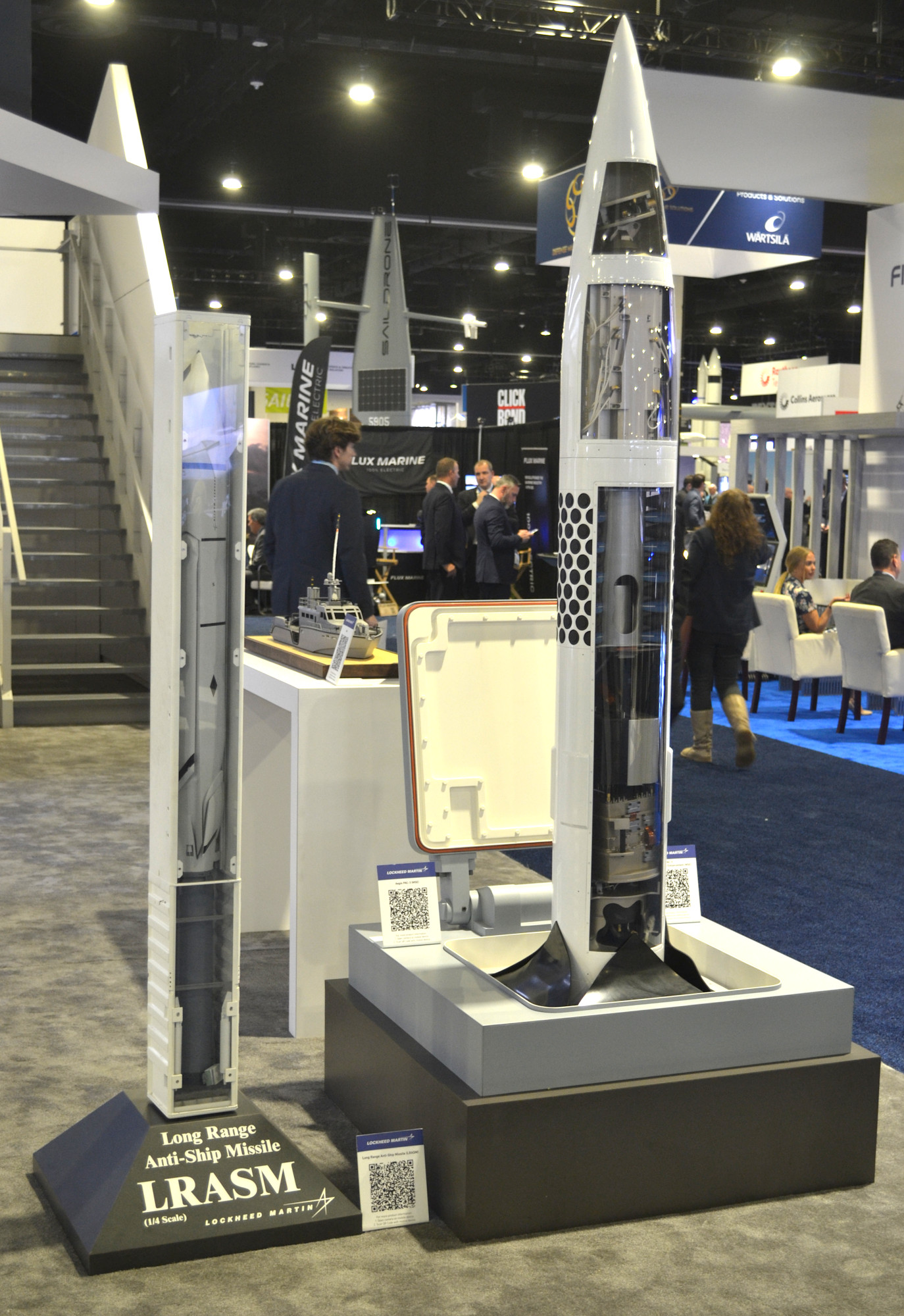
Fighting With 32 VLS Cells
By design, Constellation class frigates “are to be capable of operating in both blue water (i.e., mid ocean) and littoral (i.e., near-shore) areas, and [be] capable of operating either independently (when that is appropriate for their assigned missions) or as part of larger Navy formations,” according to a report on the ships that the Congressional Research Service (CRS) published on January 16.
Historically, “U.S. Navy frigates perform many of the same peacetime and wartime missions as U.S. Navy cruisers and destroyers,” the CRS report adds. However, “since frigates are intended to do so in lower-threat areas, they are equipped with fewer weapons, less-capable radars and other systems, and less engineering redundancy and survivability than cruisers and destroyers.”
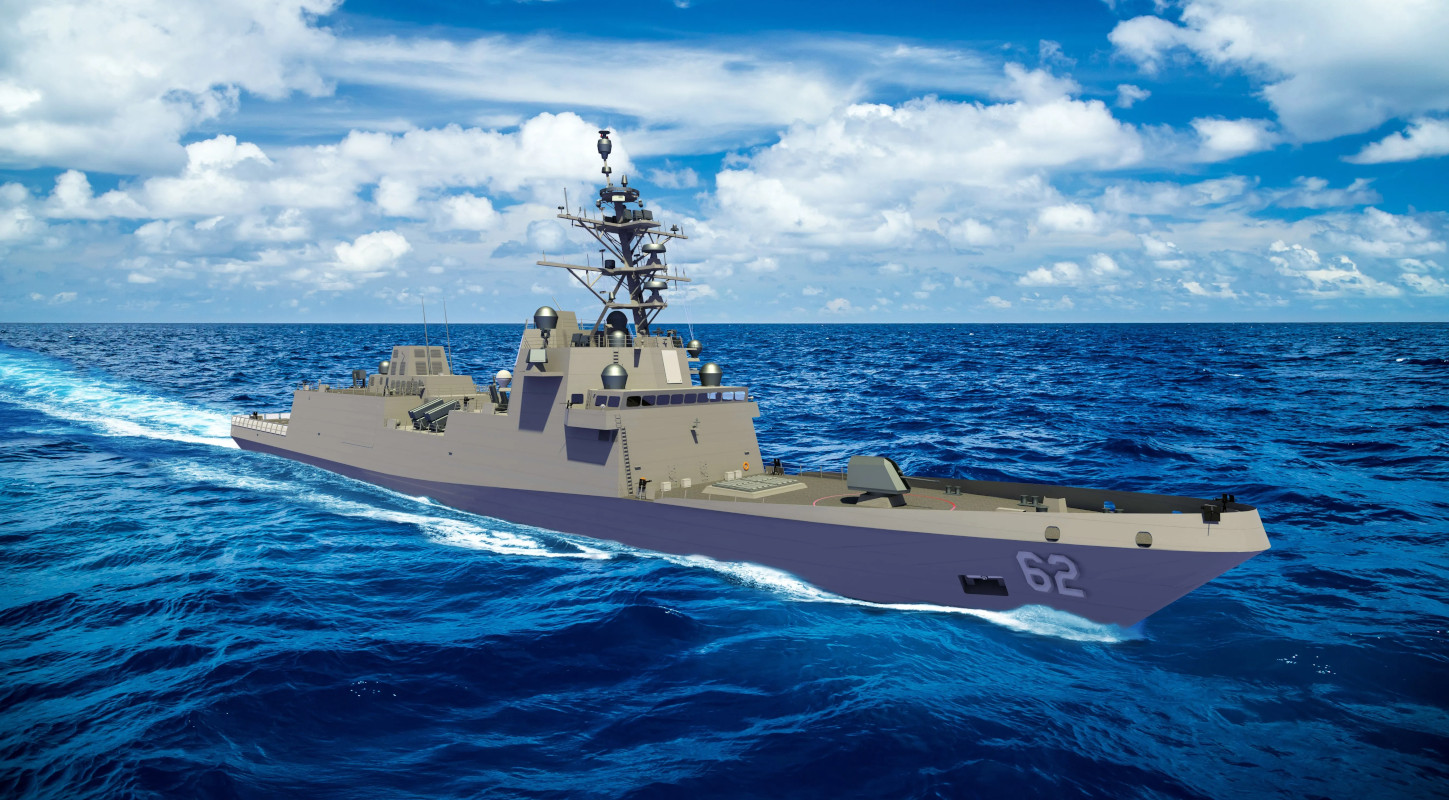
CRS also provides the following more detailed description of potential peacetime and wartime missions Navy frigates could be called upon to perform:
“Peacetime missions performed by frigates can include, among other things, engagement with allied and partner navies, maritime security operations (such as anti-piracy operations), and humanitarian assistance and disaster response (HA/DR) operations. Intended wartime operations of frigates include escorting (i.e., protecting) military supply and transport ships and civilian cargo ships that are moving through potentially dangerous waters. In support of intended wartime operations, frigates are designed to conduct anti-air warfare (AAW—aka air defense) operations, anti-surface warfare (ASuW) operations (meaning operations against enemy surface ships and craft), and antisubmarine warfare (ASW) operations. U.S. Navy frigates are designed to operate in larger Navy formations or as solitary ships. Operations as solitary ships can include the peacetime operations mentioned above.”
As it stands now, when USS Constellation enters service it will able to a carry a maximum of 32 Block IIIC SM-2s or 128 ESSMs, but that would never be the case as it would deploy with a mixture of both. Some of its VLS cells could be taken up by VLAs or another similar type of anti-submarine weapon, as well. As noted, SM-6 and Tomahawk are expected to be added to this mix in the future.
A key benefit of VLSs like the Mk 41 is the flexibility they offer in terms of loadout over missile-specific launch systems. Just as a hypothetical example, the 32 total strike-length cells, a future Constellation class frigate could carry an air and missile defense-centric load of 10 SM-6, 16 SM-2, 24 ESSMs. For more multi-role operations, 8 Tomahawks, 6 SM-6, 14 SM-2 and 16 ESSM could be loaded into the ship’s VLS cells. Or 6 Tomahawks, 4 SM-6s, 12 SM-2s, and 6 ASROCs, and 16 ESSMs to include anti-submarine warfare weapons capability. You can plug and play the numbers however you like, just like the Navy.
In terms of overall missile armament, each Constellation class frigate will also be armed with 16 RGM-184 Naval Strike Missile (NSM) cruise missiles (which have anti-ship and land-attack capabilities) loaded on a quartet of four-round deck launchers amidships. The Navy is already in the process of integrating NSM on its Independence and Freedom class Littoral Combat Ships (LCS) and the U.S. Marine Corps is fielding it in a ground-launch form.

The ships will all have a single launcher loaded with RIM-116 Rolling Airframe Missiles (RAM) for close-in defense, too. The complete armament package for the Navy’s new frigates also includes a 57mm gun in a turret on the bow and mounts for crew-operated machine guns at various points along the deck.
The Navy is pushing to integrate more directed energy weapons, including various tiers of laser and high-power microwave types, across its surface fleets. This could be another potential capability for Constellation in the future.
The weapons on the Navy’s next class of frigates will be tied to a version of Lockheed Martin’s COMBATSS-21 battle management system, which is derived from the combat-proven Aegis Combat System. This system will also be linked to the ship’s AN/SPY-6(V)3 Enterprise Air Surveillance Radar (EASR) and the AN/SPS-73(V)18 Next Generation Surface Search Radar.

“They’re actually calling it [Constellation‘s battle management system] now the Frigate Aegis Weapon System, as an indication that the intention is that the frigate will be closer in capability to an Aegis ship,” Rich Calabrese, Director of Surface Navy Mission Systems for Lockheed Martin, previously told The War Zone.
At this year’s SNA symposium, Rear Adm. Smith highlighted to USNI News how the common software library that Aegis uses would be a major help for integrating SM-6 onto these ships in the future. It could aid in the integration of other weapons, too. You can read more about Aegis and its derivatives, in detail in this past War Zone feature.

Each Constellation will also have an AN/SLQ-32(V)6 Surface Electronic Warfare Improvement Program (SEWIP) Block II suite capable of passively geolocating, identifying, and classifying a multiple of threats. A scaled-down version of the improved AN/SLQ-32(V)7 SEWIP Block III system that is now being added to some of the Navy’s Arleigh Burke class destroyers is in development and could find its way onto these frigates in the future.

On top of its onboard weapons and other mission systems, each Constellation class frigate will be to embark an MH-60R Seahawk helicopter and an MQ-8C Firescout drone helicopter. MH-60Rs can be armed with AGM-114 Hellfire missiles. Serving as the ship’s primary anti-submarine weapon, these helicopters can also deploy sonobuoys and lightweight anti-submarine torpedoes. They will also be able to carry an advanced electronic warfare pod in the future. The Navy’s MQ-8Cs are currently unarmed, but the service has been looking into integrating weapons and other stores onto these drones. In addition, both the MH-60R and MQ-8C have sensor turrets with electro-optical and infrared cameras that could be used to help find targets and otherwise improve the ship’s general situational awareness.
Real World Lessons Emerging From The Red Sea
Recent events in and around the Red Sea have put a new spotlight on the debate around whether or not the Constellation class frigates will still have too few VLS cells to be highly effective, especially during sustained independent operations.
Since October 19, 2023, Navy Arleigh Burke class destroyers and aircraft have shot down at least 68 drones and 19 anti-ship missiles (a mixture of ballistic and cruise types) launched by Iranian-backed Houthi militants in Yemen, according to press releases from U.S. Central Command. A single Burke, the USS Carney, is alone responsible for at least 37 of these intercepts.
British and French forces, including the French Navy’s Aquitaine class frigate Languedoc (a FREMM type), have downed additional Houthi drones. The Yemeni militants have launched even more drones and missiles that have not been intercepted in that same time span, some of which have struck commercial ships passing through the region.
U.S. forces have also destroyed several small boats at sea and dozens of Houthi targets on land, including in the course of strikes conducted in cooperation with the United Kingdom.
Houthi attacks on ships in and around Red Sea have become somewhat routine since October. At the time of writing, the group has scored hits on multiple commercial ships, causing significant damage in several cases. However, there have been no casualties and no ships have been sunk.
In addition, the Houthi’s missiles and drones, while definitely dangerous, are on the lower-end of the threat spectrum capability wise, especially compared to weapon systems fielded by near-peer competitors like China or Russia.
Even so, 75 drones and 19 missiles is still more than twice the number of VLS cells on a single Constellation class frigate. In some cases, it is standard practice to fire more than one missile at an incoming air or missile threat to improve the chances of a successful intercept. So the actual missile use count could and likely is substantially higher than that total.
It’s important to note that the exact mix of missiles that Navy Arleigh Burke destroyers have been employing to shoot down Houthi missiles and drones is unknown. To date, the only type of ship-launched missile that has been confirmed to have been employed in the course of these operations is the SM-2, but others have likely been used, as well.
There is at least one report of a Burke using its 5-inch deck gun against Houthi targets, too. In addition, fighter aircraft have also been shooting down a small number of Houthi cruise missiles and drones. It is worth noting that the Constellation‘s 57mm gun, as well as future directed energy weapons, could also be used in the anti-air role, particularly against lower-tier drones, but only in relative close proximity to the host ship.
While it is far more cost effective to use directed energy weapons than using missiles, waiting for a potentially hostile weapon to get within close range of an asset costing a billion or billions dollars and loaded with sailors is not logical. During large volume attacks, this is even more of an issue as these weapons require dwell time to have an effect on their targets. So, for the foreseeable future, these capabilities will be very relevant to the close-in defensive roles, and will add a valuable defensive layer to these ships, but they do not pack the range to compete with other weapons they have at their disposal.

Regardless, the Houthis have also given the Navy just a taste of the challenges involved in responding to complex, layered attacks involving large volumes of drones and different types of missiles, all flying in different envelopes and and potentially approaching from different vectors. Anti-ship ballistic missiles, in particular present unique challenges to intercept given the very high speeds they reach in the terminal phase of flight.
The SM-2 Block IIIC missiles that Constellations will be armed with incorporate some of the improved capabilities found on the SM-6, including its active radar seeker. However, they are still nowhere near as capable as the SM-6, which these frigates will hopefully receive in the future, especially in the ballistic missile defense role.
The Yemeni militants have become the first to have fired anti-ship ballistic missiles in anger, but other countries, especially China, are fielding much more capable weapons of this general type and/or are developing new ones. The U.S. Army is looking to start deploying its own anti-ship ballistic missile, a variant of its new Precision Strike Missile (PrSM) short-range ballistic missile, in 2026.

In turn, there is a growing need for warships to be able to defend themselves against ballistic missile attacks. An anti-air suite optimized to engage air breathing threats with no ballistic missile defense capability, no matter how capable, will only leave warships, especially those operating outside of the an Aegis Combat System umbrella, increasing vulnerable going forward. Other countries, such as the United Kingdom, are clearly seeing the same reality emerging that demand for this capability and are working to add it to existing ships. Even those with limited capabilities against low-end anti-ship ballistic missiles, like those being used by the Houthis, will be left vulnerable against higher-performing weapons fielded by near-peer state rivals.
Houthi attacks in and around the Red Sea in recent months have only further rammed home the threat posed by drones, which has been real for years and is only becoming more pronounced on and off traditional battlefields. The war in Ukraine and the current conflict in the Gaza Strip have also been key examples of how drones, and the need to protect against them, are having a transformational effect on military operations around the world.
The USS Carney shooting down 19 Houthi drones just on the night of October 19, 2023, underscores how large volumes of even relatively cheap uncrewed aircraft could overwhelm shipboard defenses and quickly deplete missile magazines. Higher-end fully-networked swarms consisting of drones with high degrees of autonomy would be even more challenging.
U.S. warships, as well as forces ashore, would see exponentially larger numbers of incoming missiles and drones in any future high-end conflict, such as one against the Chinese armed forces in the Pacific. This would eat into the total number of effectors on individual ships extremely quickly and, as noted earlier, it would be impossible to rely purely on close-in defense capabilities against so many targets at once and doing so even for lower volumes of targets could put the ship at great risk.
Options For More Missiles
Currently, there is no indication that the U.S. Navy intends to increase the VLS cell capacity on the Constellation class frigates, even down the line. Still, the service does look to have left the option open for doing so should that decision be made in the future.
The Navy has said in the past that the Constellation class’ hull is longer than the original FREMM design and has a greater displacement, as well as greater electric generator capacity, explicitly to accommodate “future growth.”
The Constellations will interestingly have a smaller main gun in a smaller turret than standard FREMM types, as well. Renderings and models show this leaves at least some amount of physical space on the bow end between the turret and the baseline 32-cell Mk 41 VLS array, which could possibly allow for the expansion of the latter.
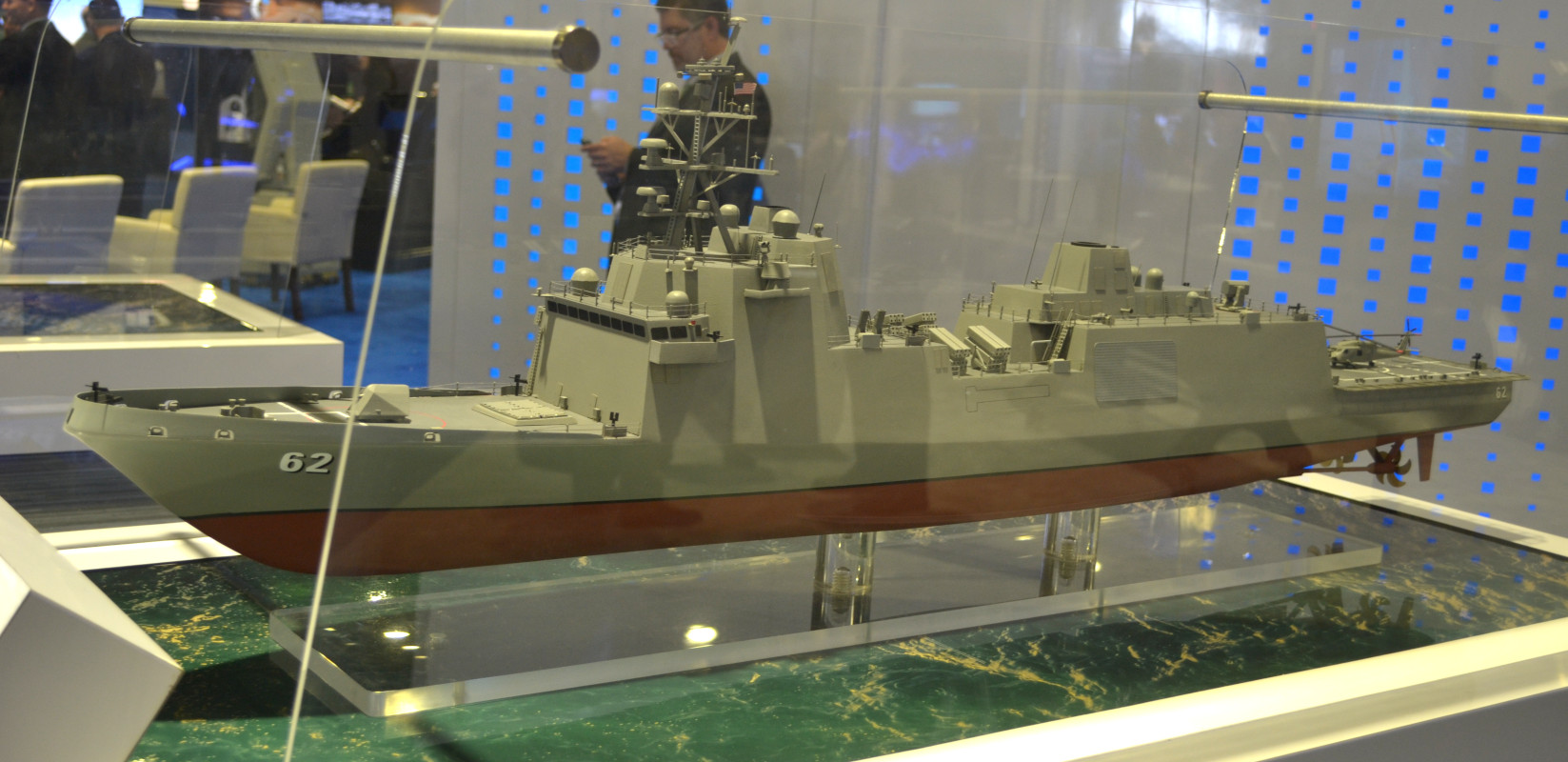
There are other options for increasing the overall missile capacity on the Constellation class frigates. One very prominent example is what BAE Systems is currently marketing as the Adaptable Deck Launching System, or ADL. Originally developed by United Defense (later acquired by BAE) in the 1990s under the name Cocoon, ADL is a deck-mounted angled launcher that can be loaded with the same types of canisterized missiles as a tactical-length Mk 41 VLS. ADL is a modular design and is currently offered in two, four, and eight-cell configurations. BAE is also working on developing a strike-length version of the ADL that would be able to accommodate larger missiles like the SM-6 and Tomahawk.

BAE Systems is already under contract to the U.S. military to develop the Next Generation Evolved Sea Sparrow Missile Launch System (NGELS) for the Navy and America’s NATO allies. NGELS is an ADL-based design and is currently primarily intended to replace existing aging Sea Sparrow launchers (now commonly loaded with ESSMs) found on various warships, including the Navy’s aircraft carriers and big-deck amphibious assault ships.
“BAE Systems designed the Adaptable Deck Launching to be scalable to multiple ship classes for the U.S. Navy and the navies of international partners and allies,” a company representative told The War Zone when asked about any discussions about adding ADLs/NGELSs to the Constellation class or other FREMM-based frigates. “The ADL is suitable for any ship class with available deck space.”
“The U.S. Navy has told BAE Systems that they are interested in three key requirements for future weapons systems for surface ships: 1) Increased lethality and survivability of surface ships, 2) Increased capacity of that lethal capability, and 3) Affordable cost-per-engagement,” the representative from the company added, speaking more generally. “The Adaptable Deck Launching System is one of the solutions that BAE Systems has developed in coordination with the U.S. Navy to answer these three requirements.”
Lockheed Martin has also been developing a host of launch systems in recent years derived from that design and that can use the same kinds of canisterized missiles. This includes the containerized Mk 70 Expeditionary Launch, variants and derivatives of which the Navy has now tested aboard multiple ships, as well as in a ground-based trailer-mounted configuration. The Army is also acquiring a ground-based Mk 41-derived system called Typhon.
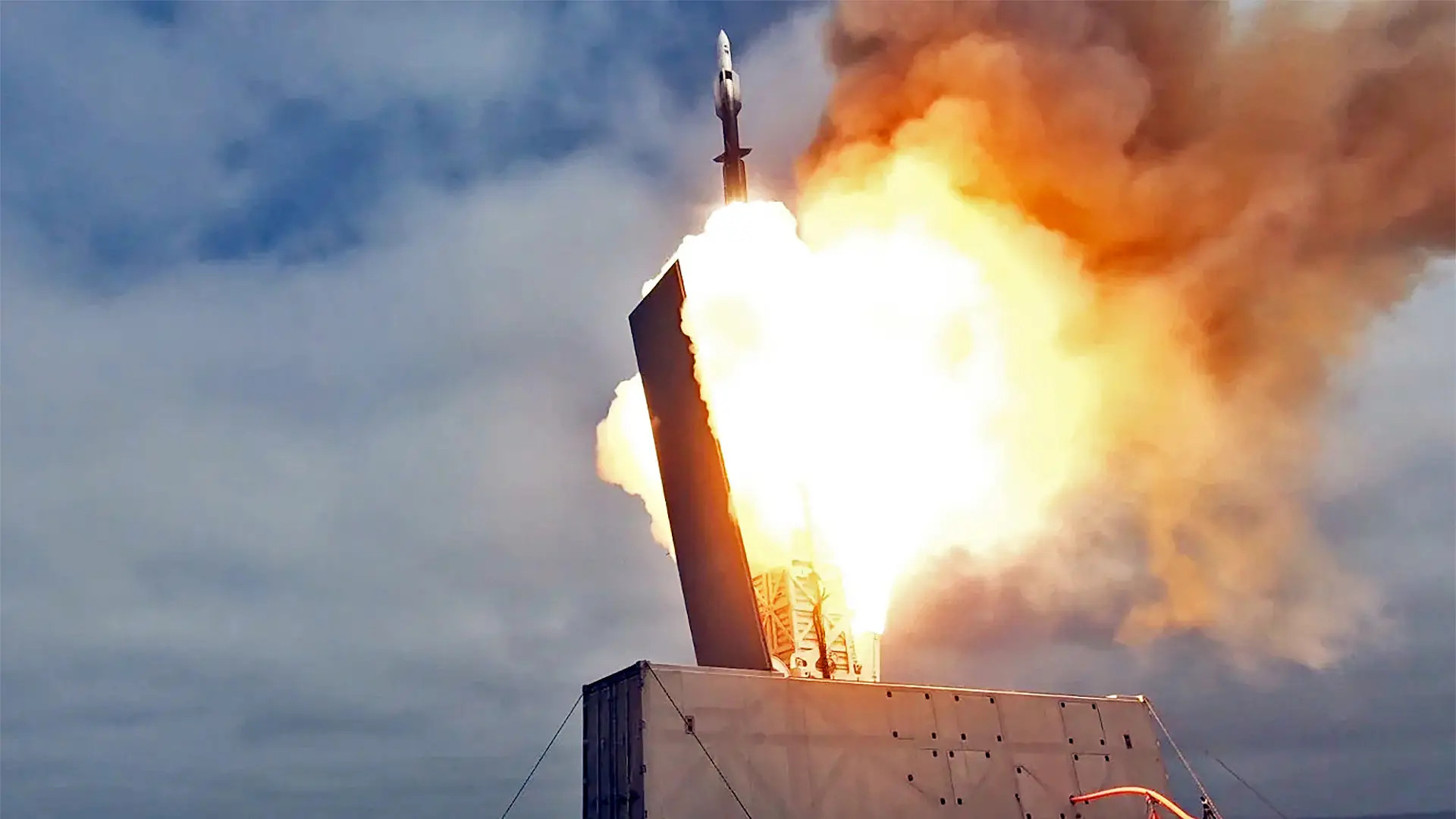
Since 2018, Northrop Grumman has been developing another containzered launch system, something The War Zone was first to report on, which could have naval applications. What is now called the Modular Payload System has been in development primarily in connection with AGM-88G Advanced Anti-Radiation Guided Missile Extended Range (AARGM-ER) radar-busting anti-radiation missile, as well as more general strike derivatives of that weapon. The War Zone has reached out To Northrop Grumman for more information about this launcher, including what other munitions it might be able to fire.
Versions of Lockheed Martin’s Mk 70 or Northrop Grumman’s Modular Payload System could be installed to the Constellation‘s stern helipad for an immediate boost in firepower. This would, of course, limit, if not entirely eliminate the ship’s ability to use the helipad for its intended purpose. Replacing Naval Strike Missile launchers, may be another option, but that would trade capability and the constraints of the available mounting area may preclude it.
There could be other ‘bolt-on’ solutions, including missile-specific launch systems, to increasing the total missile capacity of each Constellation class frigate. This includes the deck-mounted launcher for LRASM seen below.
Expanding the ship’s size even further is another potential option, although the feasibility of this is unclear at this time. Stretching the ship would could allow for enough room to install another VLS array, beyond any extra space that is available right now for expansion. But that may not be needed if there is already space for this in the current design.
VLS Capacity Issues Go Beyond Constellation
Debates around total number of vertical launch cells on the Constellation class frigates are reflective of broader discussions within the U.S. Navy. The flash point that has emerged in and around the Red Sea in recent months has similarly underscored these more general concerns.
The dozens of drones and missiles that Yemen’s Houthis have been launching are likely putting put a strain on the larger missile arsenals of the Navy’s Arleigh Burke class destroyers that are currently serving as the primary defense against them. As noted earlier, not all of the VLS cells on those ships are loaded with anti-air and missile defense interceptors, either. Burkes have fired Tomahawks at Houthi targets ashore on multiple occasions in recent weeks.
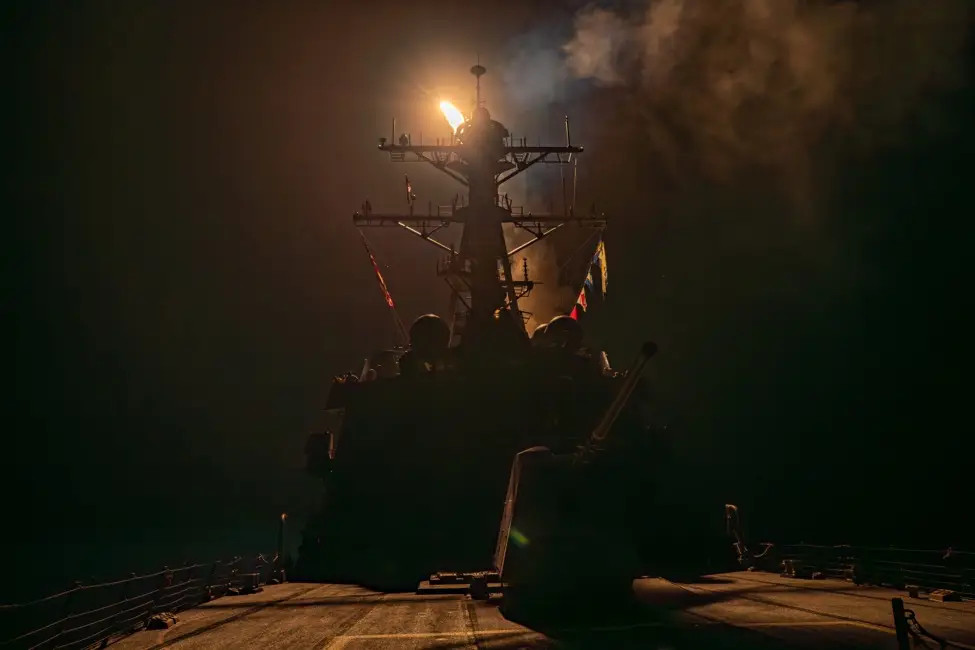
In addition, the Navy is expecting to see a major drop in overall VLS capacity, both on surface warships and submarines, between now and 2030, at least. This is being driven mostly by the service’s planned retirement of all of its Ticonderoga class cruisers and its four Ohio class guided missile submarines (SSGN) by the end of the decade.
As already noted, each one of the Navy’s 13 remaining Ticonderogas has 122 VLS cells. So, decommissioning all of these warships will lead to the loss of a staggering 1,586 VLS cells in total.
Each one of the Ohio SSGNs, which were converted from Ohio class ballistic missile submarines, can carry a maximum of 154 vertically-launched Tomahawks in their modified missile tubes. However, 100 missiles is a more typical load for those boats, which are really multi-mission platforms that can also serve as staging bases special operations forces and underwater command and control and intelligence fusion nodes. You can read ore about the Ohio SSGNs, were are some of the most in-demand vessels in Navy service today, in this past War Zone feature.
The Navy hopes that its downward VLS capacity trend will start to really reverse course between 2035 and 2040, with the acquisition of additional Flight III Arleigh Burkes, the Constellation class frigates, a new class of destroyers currently referred to as DDG(X), and expanded subvariants of the Virginia class attack submarine. More dedicated replacements for the Ohio SSGNs could also start to arrive in the early 2040s.
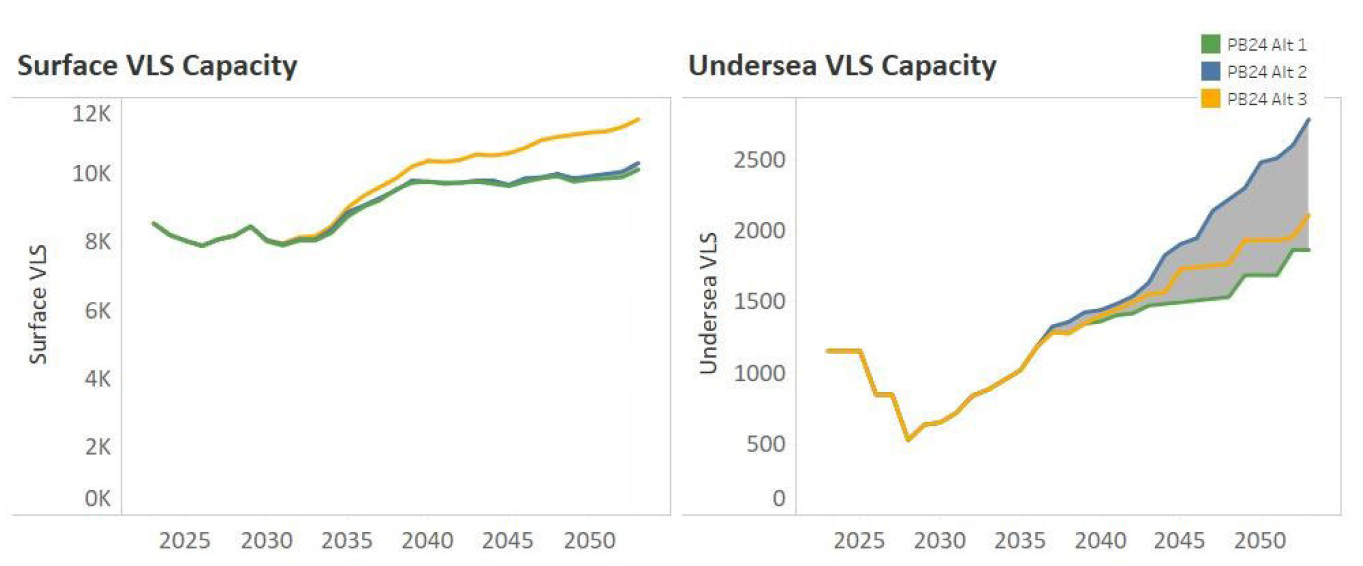
The Navy could consider bolt-on missile launcher options for other surface combatants, as well, to help make up for the loss in capacity over next decade or so.
At SNA’s 36th National Symposium, BAE Systems notably showed off a model of the USS Jack H. Lucas (DDG-125), the first Flight III Arleigh Burke, with eight two-cell ADLs installed at various points around the ship. The company also released a video, seen in the social media post below, depicting the USS Michael Murphy, a Flight IIA Burke, with a pair of two-cell ADLs added on at the stern end.
“When I was commanding officer of a U.S. Navy destroyer and later commodore of our ships in Europe and Africa, I was always thinking, for a high-end fight, I’ve only got 96 cells available,” Tate Westbrook, Director Of Business Development for Surface Guns & Missile Launchers at BAE Systems and a retired Navy surface warfare officer, told Naval News at the SNA conference this month. “With the adaptable deck launcher, as show here [on the USS Jack H. Lucas model], up to eight launchers on deck with evolved sea sparrow would provide an additional 64 missiles for short and medium-range ship defense.”
It isn’t clear if there is any room to install similar launchers on Constellation frigates beyond the flight deck, without sacrificing Naval Strike Missiles, due to the much tighter confines of the design.
There has been discussion in recent years about arming a wider array of Navy ships, including sealift ships and other auxiliaries, with bolt-on missile launchers to help increase overall capacity.
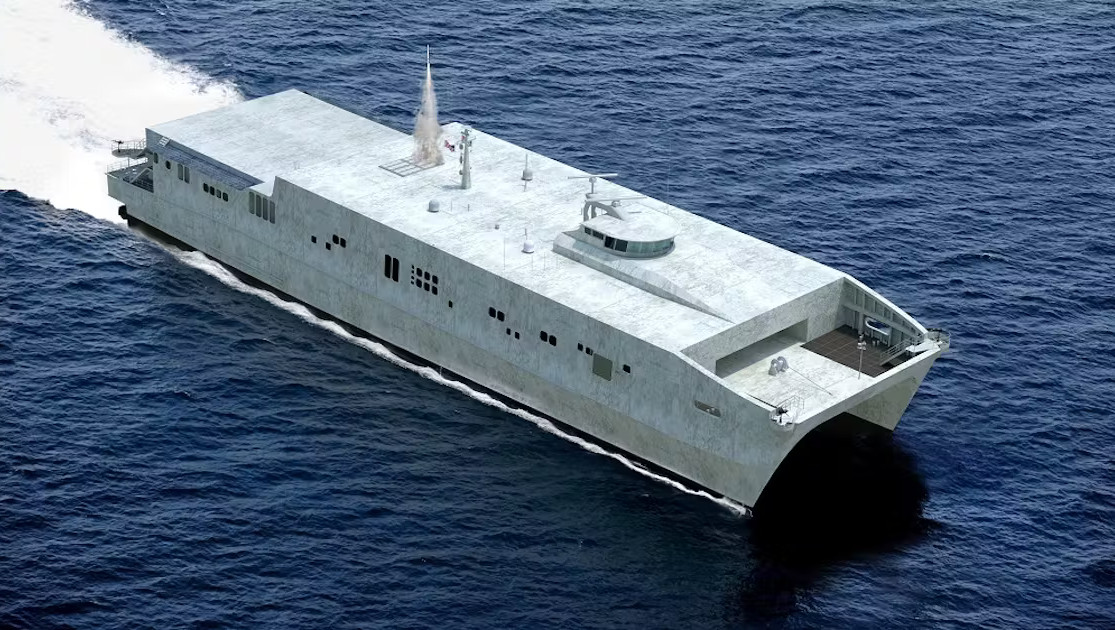
The service has also been looking toward acquiring larger uncrewed surface vessels that could be loaded with VLS cells, either via built-in launchers or modular add-on options.
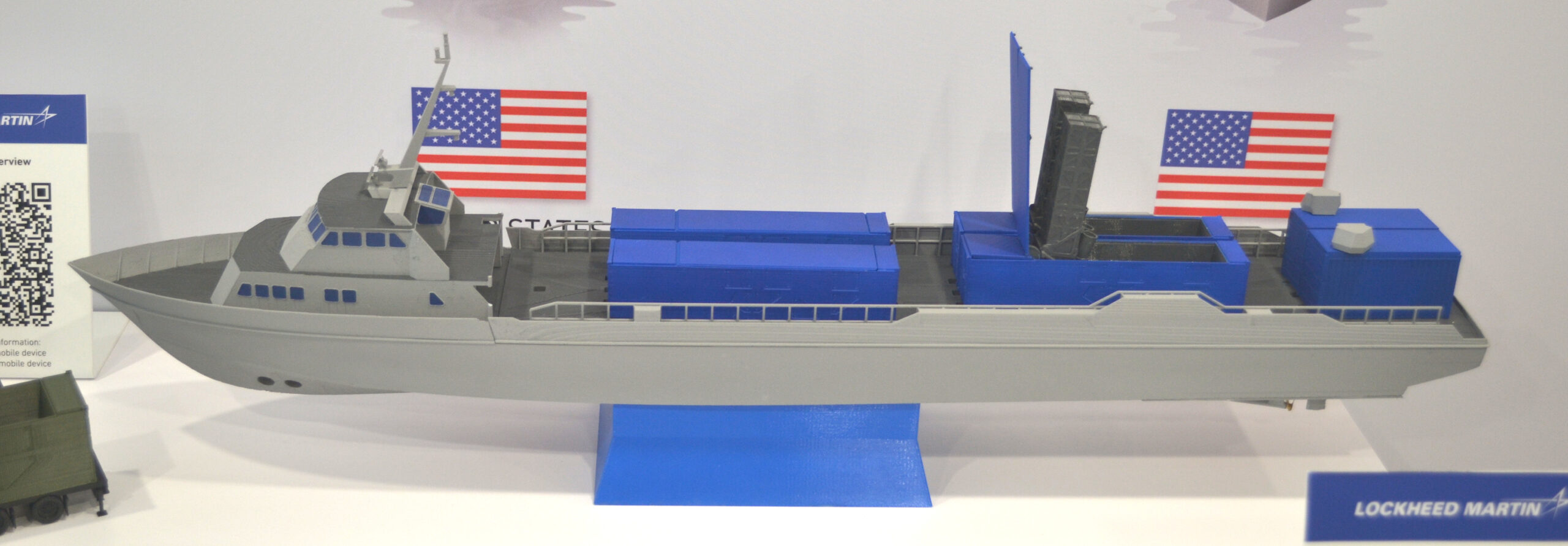
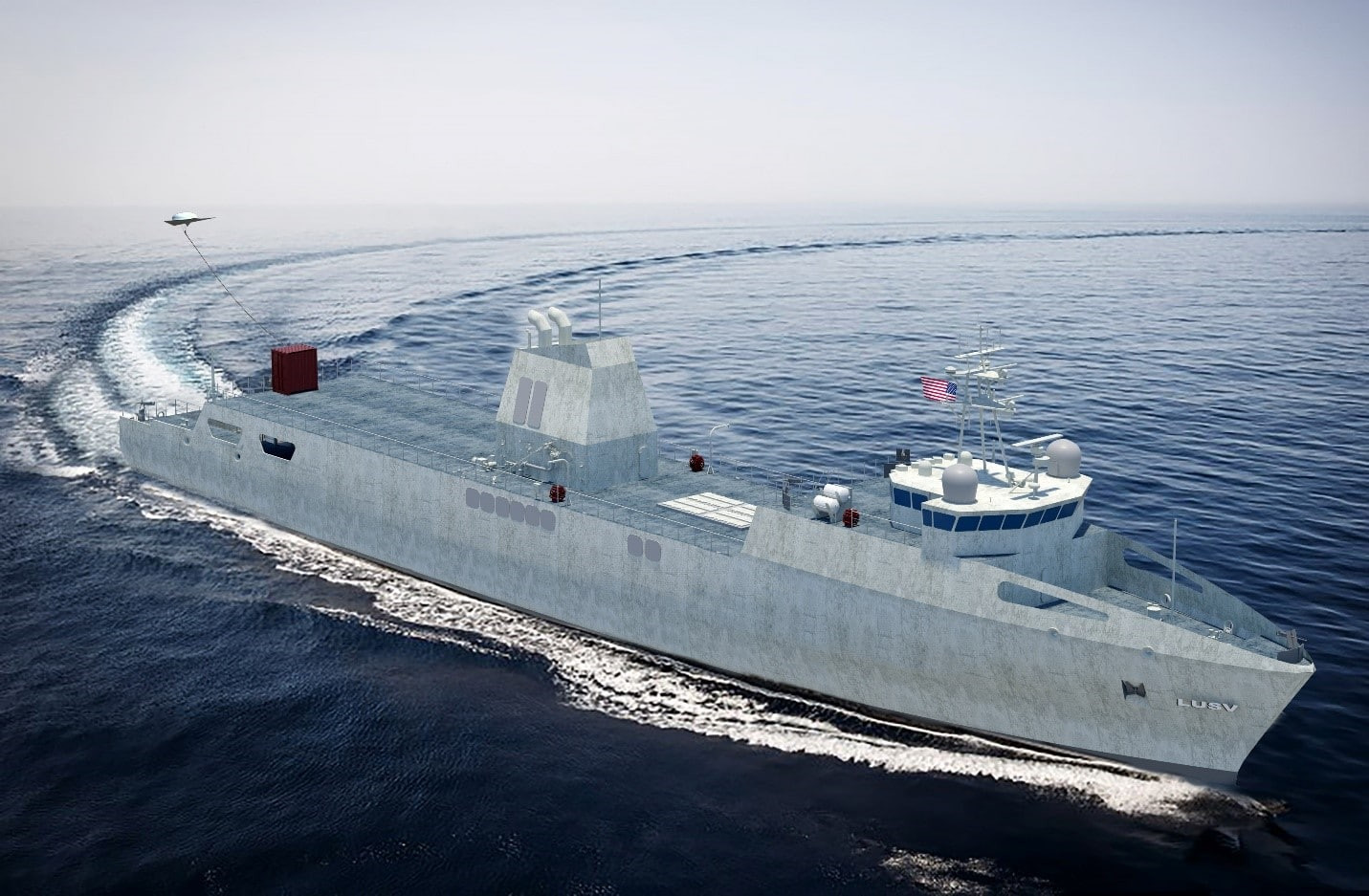
The idea of the Navy acquiring a fleet of dedicated arsenal ships of some kind, either crewed or uncrewed, has come up multiple times in the past few decades.
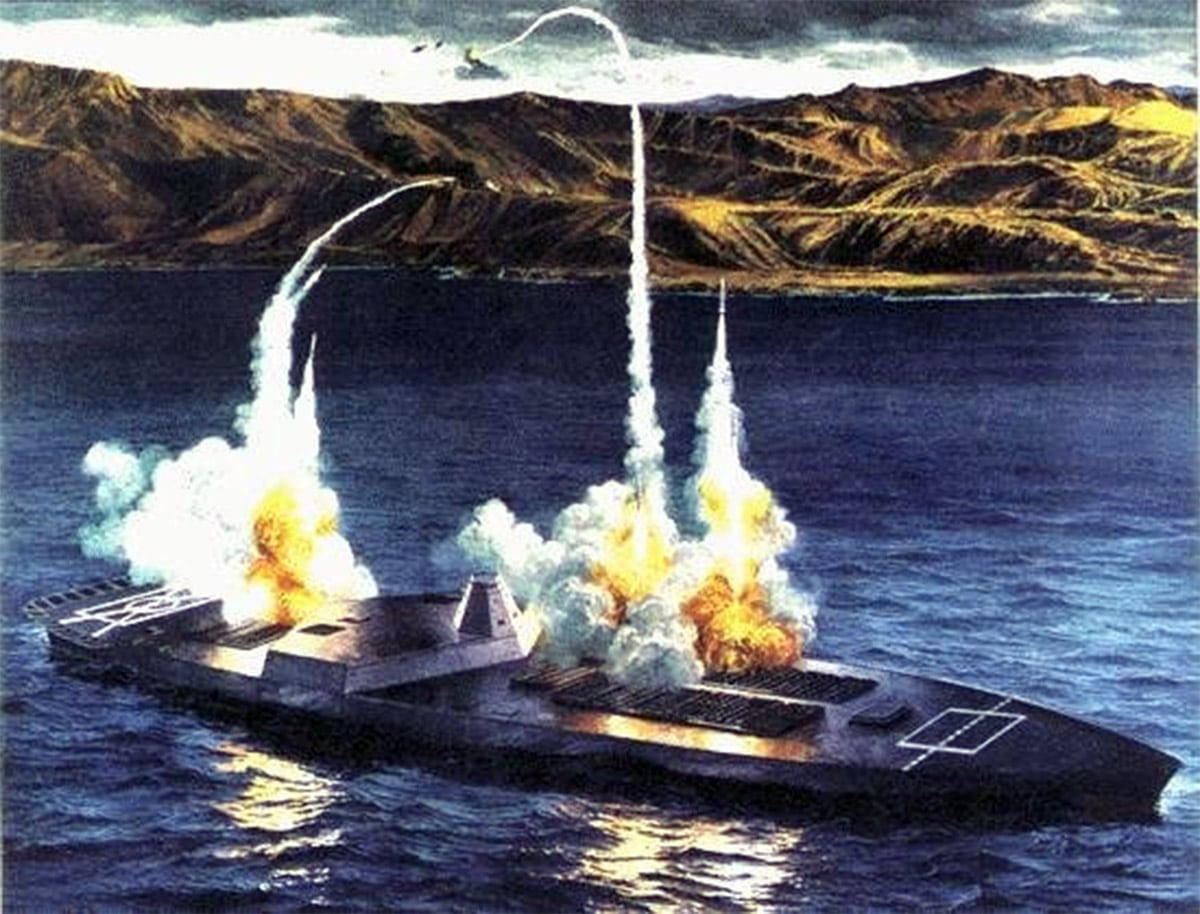
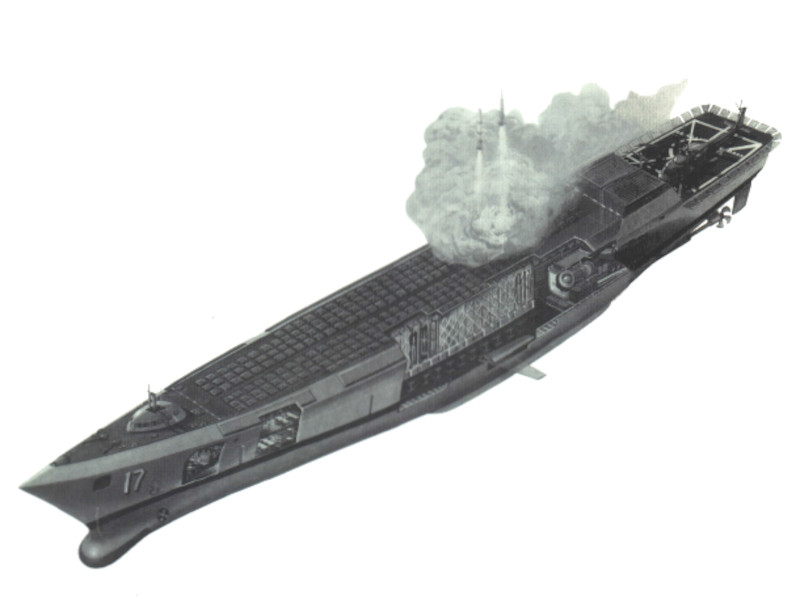
In recent years, the Navy has also been stressing that more capable ships and munitions, even in smaller numbers, as well as other advanced capabilities could help offset the near-term loss of VLS capacity.
“For us to pivot, under the budget line that we have right now, to pivot to a more lethal force, we need to give up some stuff,” now-retired Adm. Mike Gilday, then Chief of Naval Operations (CNO), told reporters in Febraury 2022. “And you can’t just look at it through the lens of surface VLS [vertical launch system] tubes.”
This has been part of a more general discussion about the overall size of the Navy’s fleets and available U.S. military shipbuilding capacity, the latter of which is exponentially smaller than that of China. The Chinese armed forces are America’s current pacing threat, meanin they are the primary potential adversarial against when the U.S. military is planning around both in terms of policy and acquisitions. There are growing concerns about the potential for a real high-end conflict between the United States and China, potentially over the status Taiwan or another major flashpoint like the South China Sea, before 2030.
The Issue of Reloading At Sea
Beyond VLS cells and ships to put them on, there is also the need to be able to get missiles into those launchers. As it stands now, the Navy has no real capacity to conduct at-sea rearming of Mk 41 or Mk 57 VLS arrays. The Navy’s submarine tenders can help load missiles and torpedoes onto submarines at sea, but the service currently only has two of these ships. This service is now looking to replace those ships with a new tender design, currently referred to as AS(X).
What this all means currently is that in a real future conflict, in most cases, surface warships and submarines would have to return to an established port to reload. These facilities and any stationary vessels docked at them would be prime targets for an opponent.
Any vessel in need of re-arming would also have to leave its station for at least some amount of time and could be more vulnerable during its transit depending on its remaining weapon load. In a future conflict in the Pacific, potentially against China, ships could easily have to travel extreme distances, over thousands of miles, to get from operational areas to a safe port for reloading.
The Navy is aware of this issue and its seriousness, and is now actively pushing to develop new at-sea re-arming capabilities. Additional tests of a modular Transportable Re-Arming Mechanism (TRAM) system are expected to occur later this year. The service has tested similar capabilities intermittently over the year.

TRAM, as it currently exists, is designed to be used in conjunction with existing Navy at-sea replenish ships and will be able to reload VLS cells on surface ships at up to Sea State 5, per Naval News. The Beaufort Scale defines Sea State 5 as conditions involving moderate winds between 17 and 21 knots and moderate waves between six and eight feet.
“The near-term deterrent effect of fielding TRAM in the Fleet cannot be overstated.” Secretary of the Navy Carlos Del Toro said at the 36th SNA Symposium. “[This is] a game changing [capability] that will be operational within two to three years, and will make our surface navy more formidable, serving as a powerful maritime deterrent.”
“This issue about re-arming our destroyers in the Red Sea today is far more relevant, I assure you, than it was a year ago when we first started thinking about this,” Del Toro added.
Deploying at-sea rearming ships would bring its own risks and additional operational demands. Auxiliary ships equipped with TRAM and loaded with munitions would need escorts to protect them during operations in forward areas. This would likely be a major job for the Constellation class, for instance. Beyond just fixed facilities, logistics chains, in general, are typically major targets for enemy forces in a conflict.
“We need to acknowledge that we should assume…they’re going to challenge our sustainment,” then Marine Corps Commandant Gen. David Berger said in 2022 about logistics in a notional future high-conflict with China. “[We need a] real relook at everything from pre-positioning ashore to pre-positioning afloat to the lift that conventionally has gone across the ocean through this solid protected pipeline delivered in some big port.”
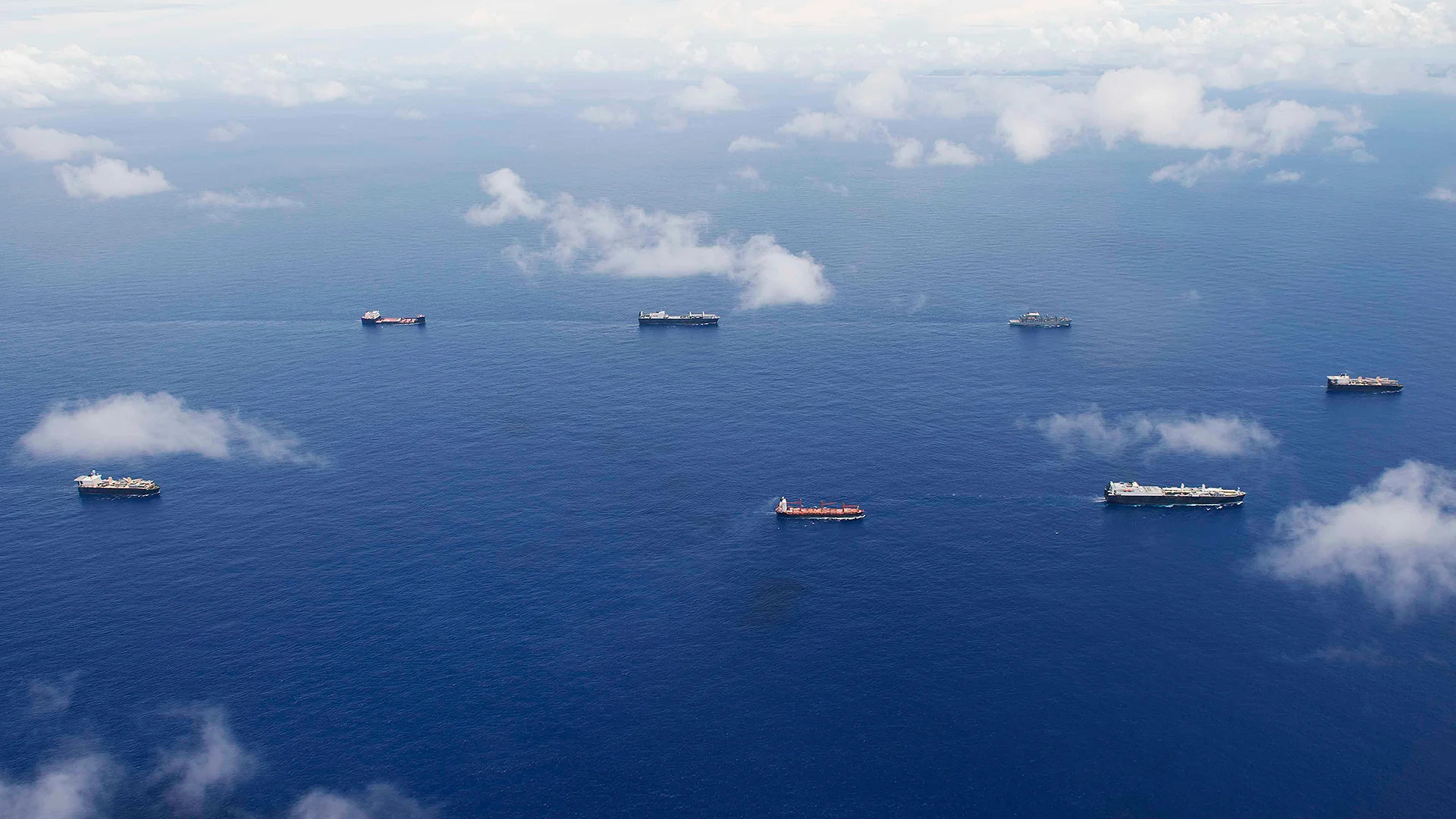
The demand for at-sea reloading could open up opportunities for alternatives to existing VLSs like the Mk 41, as well. BAE System’s current pitch for ADL is based in part on the system’s possible benefits in this regard.
“The U.S. Navy has publicly mentioned their prioritization of rapid rearming at-sea. The design of the Adaptable Deck Launching System features large opening doors at the top of the launcher that provide quick, easy horizontal loading of the entire canistered missile from above,” a company representative told The War Zone. “As the mechanical design agent for the Mk 41 Vertical Launching System (VLS) and manufacturer of all Mk 41 missile canisters, we understand the challenge of loading any missile and have utilized our knowledge and expertise in this area to provide the Navy with an adaptable deck launching system solution that meets both current and future warfighting needs.”
Industrial Base Concerns
Talk about VLS cells and other launcher capacity, and about the ease of reloading them, is moot if there are no missiles to put in them in the first place. The war in Ukraine has prompted the U.S. military to do some serious rethinking about production capacity and stockpiling of all kinds of munitions. The Department of Defense, as a whole, is trying to take action on this front, but it is expected to take years to really ramp things up.
This has all only been further underscored by the crisis in and around the Red Sea.
To put things in some perspective, in its 2024 Fiscal Year budget request, the Navy asked for funds to buy 24 SM-2 Block IIIC missiles. This was on top of funding the service secured to acquire 80 more of those missiles between Fiscal Years 2021 and Fiscal Years 2023. Each one of these missiles costs around $2 million.
In Fiscal Year 2024, the Navy also asked for money to purchase 147 RIM-162 ESSMs, in addition to 354 of these missiles it had received funding for between Fiscal Years 2021 and 2023. The unit cost of a single one of these weapons is around $1.5 million.
Each SM-6 missile is significantly more expensive than an SM-2 Block IIIC or ESSM. The current unit cost for a single Block IA variant of the SM-6 is around $4.2 million, according to Navy budget documents. The super-sized Block IB version, which is more capable all around, has a unit price roughly double that, at around $8.5 million. In its proposed budget for the 2024 Fiscal Year, the Navy asked for funding to buy 115 Block 1A and 10 Block IB missiles (this was the first budget request to include planned purchases of the latter type). The service had received funding for 375 Block I/IA SM-6s between the 2021 and 2023 Fiscal Years.
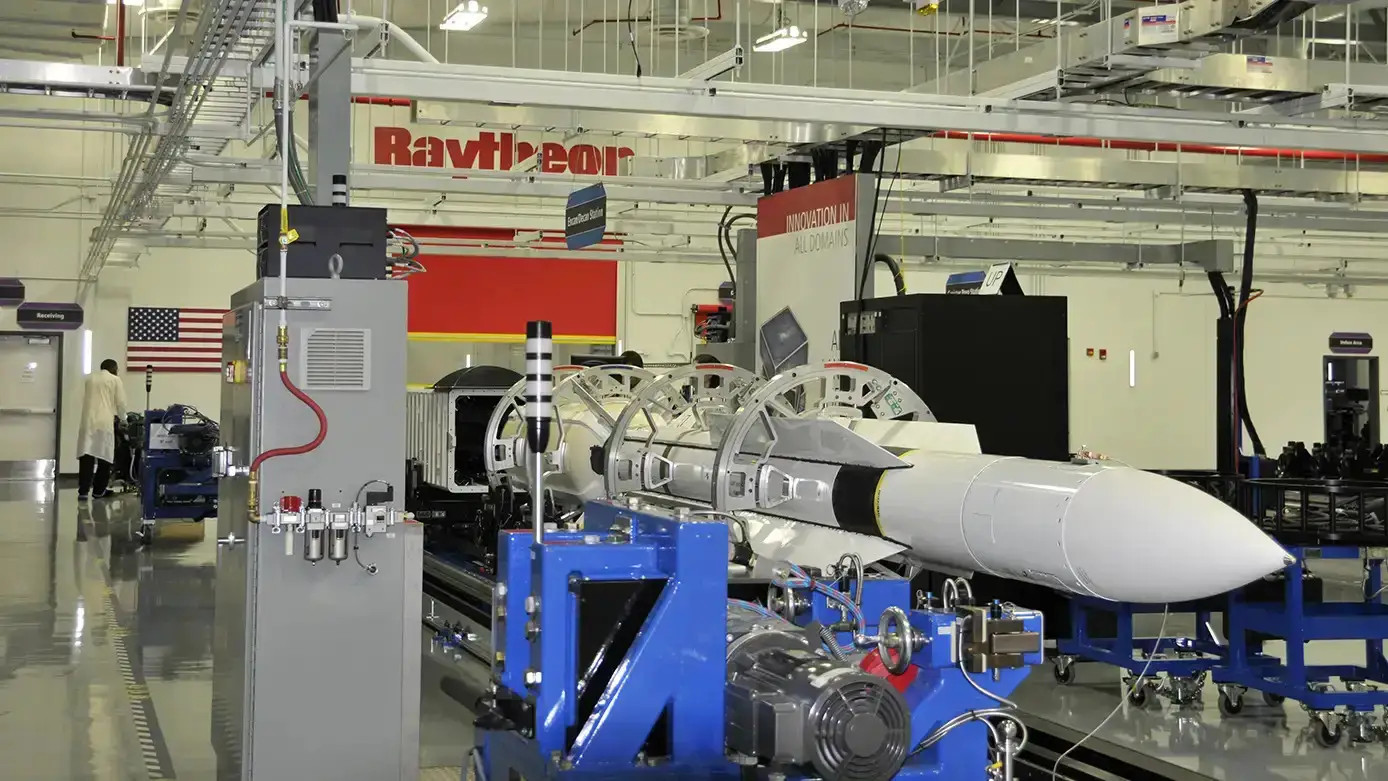
As already pointed out, American warships and aircraft have expended dozens, and potentially hundreds, of missiles of various types, to shoot down Houthi missiles and drones just in recent months. This again has been in the course of what is a limited conflict contained with a relatively tightly confined theater of operations.
The Navy, as well as the Air Force, have been looking to get funding for larger, multi-year purchases of missiles and other munitions to try to help expand the available industrial base and bolster stockpiles. However, some members of Congress have expressed wariness about these plans, especially given the current performance of certain contractors in meeting existing quotas. A host of factors are, of course, at play, including higher-than-expected inflation and other negative economic fallout driven by a host global crises in recent years.
As a prime example, just last week, Bloomberg reported that Raytheon has only delivered half of the SM-6 missiles from a contract awarded back in 2019. Continued fallout from the COVID-19 pandemic was cited as major factor.

These industrial base concerns could prompt interest in integration additional missiles onto the Constellation class frigates, as well as other Navy warships. Combining the PAC-3 MSE interceptor with the Mk 41, for instance, would provide an additional source of in-production surface-to-air missiles. Of course, many other munitions pipelines are facing the same kinds of issues. Demand for PAC-3s and other Patriot surface-to-air missiles has surged in recent years, something that is now being further driven by the conflict in Ukraine.
The United States and others have been reminded by the experience just of resupplying Ukraine in the past two years that a major conflict puts unique strains on industrial capacity. Attrition on the battlefield, enemy targeting of stockpiles and production centers, and other disruptions are all serious factors in keeping an armed force at war adequately supplied.
Altogether, the Navy faces several serious questions about its future VLS cell capacity, which will have impacts on its future air and missile defense and stand-off strike capabilities. It also needs to address challenges relating to getting missiles into those cells and making there it has the necessary stockpiles, to begin with.
When it comes to air and missile defense, in particular, the threat picture is already diverse and only growing. The Houthis have become an extremely visible example of the continued proliferation of drone and missile capabilities, even to non-state actors, and how dangerous even lower-end capabilities in this regard can be to nation-state military forces. Just this past weekend, Iranian-backed militants based in Iraq succeeded in killing three American service members and wounding dozens more in a kamikaze drone attack on a forward base in neighboring Jordan.
Larger countries with significantly greater resources, especially China, can only see this as vindication of their own efforts to acquire and field far more advanced drones and anti-ship missile systems, and in much greater quantities. All told, the incentives for actors large and small, state and non-state, to pursue these kinds of capabilities continue to mount.
Balance To The Force Protection
While more is always better, it comes at a cost. Tacking on more capabilities to a program like the FFG(X)/Constellation can quickly turn it into the exact thing it wasn’t meant not to be – a destroyer. So everything has to be looked at in terms of balancing capabilities versus cost, with the larger force structure and capability mix goals being driving factors too. Also, building more frigates, even with less capability, may be a better move than rapidly loading on more combat capacity to these ships that could rob funds from purchasing more hulls.
That being said, it is abundantly clear that these ships will need to be able to defend themselves, and vessels in their immediate vicinity under their watch, from anti-ship ballistic missiles. This would be a terminal defense capability that the SM-6 can provide. The same can be said for air breathing threats too, but that was already a given. Still, what magnitude and frequency of threats should they be able to take on by themselves, without operating under an Aegis umbrella?
This all factors into how many defensive weapons they will need to be able to carry, especially if they are competing for space with Tomahawks and anti-submarine rockets. As it sits now, they are well armed by past standards, but will that be enough even for medium-threat scenarios in the future, especially when huge volumes of drones could rapidly deplete their magazines? Considering how heavily taxed the U.S. Navy will be during a potential war in the Pacific, how independent will these ships actually be when they are needed?
Then there is the issue of concentrating too many precious missiles on a limited number of hulls, which is a continuing concern that helped keep the arsenal ship concept from moving forward. Distributed concepts, where more weapons are spread out in smaller numbers are an ongoing option, but that too has massive tradeoffs while providing additional resiliency, at least in some ways, and broader deployment coverage. Where does the proper balance lie based on the projected threat scenarios?
These are all questions the Navy will have to really ask itself going forward. Mastering VLS reloading at sea, and providing resources to see that such a capability is robust and available to the fleet, should be absolutely critical going forward. It is the cheapest way for dealing with a large part of this issue in the near term, even if it has its own drawbacks.
If anything else, the combat experienced off Yemen over the last few months has been an incredible learning opportunity for the U.S. Navy and it will help focus priorities going forward. If those include expanding the Constellation’s arsenal, we will have to wait and see.
Contact the author: joe@thewarzone.com
